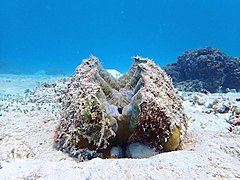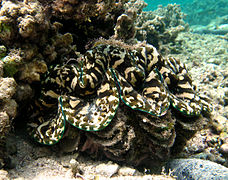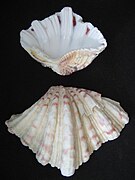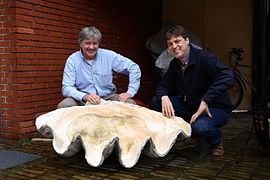Giant clams
| Giant clams | ||||||||||||
|---|---|---|---|---|---|---|---|---|---|---|---|---|

|
||||||||||||
| Systematics | ||||||||||||
|
||||||||||||
| Scientific name | ||||||||||||
| Tridacninae | ||||||||||||
| Lamarck , 1819 |
The giant clams (Tridacninae) are a mussel subfamily, to the family of cockles (Cardiidae) and thus to order Cardiida provided. The oldest members of the family come from the Ypresian ( Eocene , Palaeogene ).
features
The giant clam ( Tridacna gigas ) is the largest of all known types of clam. It can reach a length of up to 140 cm and a body mass of up to 400 kg. All giant clams live in the Indo-Pacific region and colonize coral reefs . They live with symbiotic algae , which live in their mantle lips and supply the mussel with organic matter and oxygen.
Like other mollusks, giant clams are hermaphrodites , which means that they form both male and female sexual organs. The staggered release of sperm cells and eggs reduces the likelihood of self-fertilization.
Danger
For some time now, the giant clams have been threatened with extinction due to overfishing , environmental pollution and as a result of the El Niño climate phenomenon and are on the list of the Washington Convention . Today one tries to preserve at least some of the species through targeted breeding.
Giant clams and man
There are various myths about the giant clams. To this day they are also repeatedly called "killer clams" because they - wrongly - are said to snap at divers or other living beings and hold them in the depths. In fact, the closing movement of the mussels is quite slow. In Asia it is believed that the consumption of mussel meat, especially the sphincter, has an aphrodisiac effect. The stocks there are therefore threatened due to overfishing.
Systematics
The taxon was established in 1819 by Jean-Baptiste de Lamarck. For a long time it was even placed as a superfamily to the order Venerida . The MolluscaBase only evaluates the taxon as a subfamily of cockles (Cardiidae) on the basis of molecular biological studies. There are currently 13 species in two genera:
- Subfamily giant clams (Tridacninae)
- Genus Hippopus
- Hippopus hippopus
- China giant clam ( Hippopus porcellanus )
- Genus Tridacna
- Tridacna costata
- Ingrown giant clam ( Tridacna crocea )
- Smooth giant clam ( Tridacna derasa )
- Tridacna elongatissima
- Large giant clam ( Tridacna gigas )
- Tridacna Lorenzi
- Burrowing giant clam ( Tridacna maxima )
- Devil clam ( Tridacna mbalavuana ) ( Syn . : T. tevoroa )
- Tridacna rosewateri
- Scaly giant clam ( Tridacna squamosa )
- Tridacna squamosina
- Genus Hippopus
supporting documents
literature
- Daniel Knop : Giant clams. Daehne, Ettlingen, 2nd, revised and expanded edition 2009. ISBN 978-3-935175-43-2
Individual evidence
- ↑ Yasuo Kondo and Shin-ichi Sano: Origination of extant heteroconch families: Ecological and environmental patterns in post-Paleozoic bivalve diversification. Palaeontological Research, 13: 39-44, Tokyo 2009 doi : 10.2517 / 1342-8144-13.1.039
- ↑ MolluscaBase: Tridacninae Lamarck, 1819
- ^ A b Claudio Richter, Hilly Roa-Quiaoit, Carin Jantzen, Mohammad Al-Zibdah, Marc Kochzius: Collapse of a New Living Species of Giant Clam in the Red Sea. Current Biology, 18 (17): 1349-1354, 2008 Summary
- ↑ a b c Cécile Fauvelot, Dario Zuccon, Philippe Borsa, Daphné Grulois, Hélène Magalon, Florentine Riquet, Serge Andréfouët, Michael L. Berumen, Tane H. Sinclair-Taylor, Pauline Gélin, Faustinato Behivoke, Jan Johan ter Poorten, Ellen E. Strong and Philippe Bouchet. 2020. Phylogeographical Patterns and A Cryptic Species provide New Insights Into Western Indian Ocean Giant Clams Phylogenetic Relationships and Colonization History. Journal of Biogeography. DOI: 10.1111 / jbi.13797
- ↑ WA Newman1 & ED Gomez: On the status of giant clams, relics of Tethys (Mollusca: Bivalvia: Tridacninae). Proceedings 9th International Coral Reef Symposium, Bali, Indonesia October 23-27, 2000, Vol. 2: 11 S., 2002. PDF ( Memento of the original from December 23, 2015 in the Internet Archive ) Info: The archive link was automatically inserted and not yet checked. Please check the original and archive link according to the instructions and then remove this notice.





